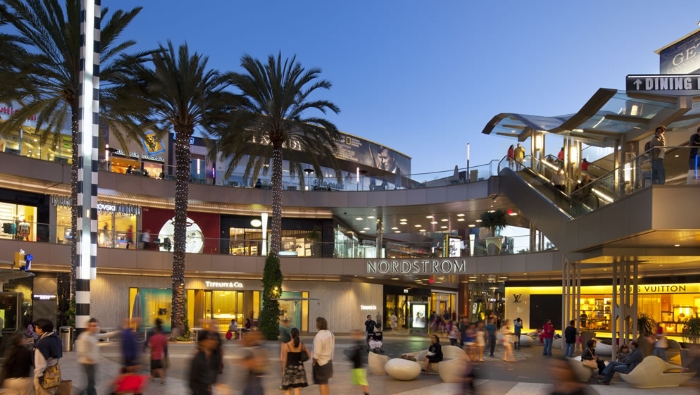One of Macerich’s properties in Santa Monica, CA. Image Source: Macerich
Macerich is a real estate investment trust that, like Simon Property Group, owns and develops high end mall properties.
History of Macerich
- Started by Mace Siegel and Richard Cohen in New York in 1964. The name of the company comes from a combination of their two names, and started out as MaceRich Real Estate Company
- In 1994 they went public (REITs were becoming more popular as an investment vehicle around this time).
- In 2002 they acquired Westcor for just under $1.5 billion, obtaining nine properties. Westcor was a commercial real estate developer from Phoenix with properties in Arizona and Colorado.
- In 2005 they obtained another 11 commercial properties from the portfolio of a company called Wilmorite Properties for about $2.3 billion.
- Simon Property Group tried to acquire Macrich in 2015, but management rejected the $16.8 billion bid.
- They have a strong relationship with the Ontario Teachers Pension Plan (OTPP), which owns over 23 MM shares, or about 16% of the company. A lot of Candadian teachers are counting (at least in a small way) on Americans continuing to shop at high end malls for their retirement!
Business Overview
- Management likes to refer to themselves as “the premier pure play high-end mall REIT”
- They own 47 regional shopping centers and 5 community centers.
- Four ways that the company does business: Acquisitions, Leasing/Management, Redevelopment, and (New) Development
- Macerich is not shy about buying existing commercial properties that it sees potential in. In fact, it looks like this has been their main growth strategy over the years.
- Leasing and Management is done in a decentralized way, so on-site staff are responsible for each particular property.
- Redevelopment of properties is key – if customers don’t find malls exciting, attractive, and fun then they won’t go there. Management looks for opportunities to buy properties and redevelop them for higher income potential.
- New Developments are something that management says they do on a selective basis. It makes sense that this would have to be more selective, because when you are buying an existing mall, you have to scout out a location, do in-depth demographic and traffic pattern research, etc. And then at that point you have to put up a large amount of money to construct the project, and the overall rate of return has to be worth it. When you buy an existing business, a system already exists and you are just improving upon it.
- They rent to a wide range of anchor tenants, who include: L Brands (Victoria’s Secret, Bath and Body Works, etc.), H&M, Forever 21, Gap, Dick’s Sporting Goods, etc. 17% of revenue comes from the top 10 tenants (though each tenant may have multiple brands/stores).
- The biggest anchors by leased square feet are Macy’s (over 2.2 MM sq. ft) and J.C. Penney (over 2.3 MM sq. ft).
Financials
|
2012 |
2019 |
CAGR (%) / Comments |
|
|
Sales |
881 MM |
927 MM |
0.7% |
|
Net Income |
366 MM |
102 MM |
Huge gain from a sale in 2012, so change is misleading. |
|
Earnings Per Share |
$2.51 |
$0.68 |
|
|
Funds From Operations |
577 MM |
537 MM |
|
|
Diluted FFO Per Share |
$4.30 |
$3.80 |
-1.7% |
|
Cash |
65 MM |
100 MM |
Cash has increased, but relative to the debt load I am not impressed. |
|
Long Term Debt |
5.2 |
5.1 |
All payable notes. Lease liabilities are not that big, in the $100-200 MM range. |
|
Operating Cash Flow |
351 MM |
355 MM |
-% |
|
Investing Cash Flow |
(963 MM) |
(112 MM) |
|
|
Financing Cash Flow |
610 MM |
(278 MM) |
Positive in 2012 b/c of loans they took out |
|
Dividends |
$2.23 (326 MM) |
$3.00 (474 MM) |
4% |
|
Shares Outstanding |
137 MM |
141 MM |
-% |
Valuation and Closing Thoughts
- Macerich is one of the largest mall REITs out there, and they have a lot of properties that seem high quality.
- Geographically, they have a reasonable number of properties spread throughout the United States but they don’t have diversification in other countries.
- Also, the debt profile for Macerich looks kind of rough. They only bring in around $350 MM in cash flow but have to service a debt load of over $6 billion (once you include different types of liabilities), and this is during pre-coronavirus times.
- In 2019 their net interest expense was somewhere around $140 MM.
- What I find so intriguing about this stock right now is the valuation. It currently trades for $8.00/share. FFO last year was $3.80/share, so we’re looking at a P/FFO of 2.1, or an “earnings yield” of 47.5%. It’s incredible!
- The dividend yield is definitely lower than it otherwise would be though – the board reduced the quarterly dividend to $0.15/share in July.
- So we are looking at $0.60/share on an annual basis, or around a 7.5% dividend yield. This makes total sense and I applaud the board for doing so – we are in unusual times.
- Even though there is a lot of debt here and quality isn’t quite the same as SPG, the relative debt to cash levels of each corporation are about the same (total debt relative to cash in the bank). SPG just has a lot more properties and is more diversified geographically.
The valuation is just so low here…but it only matters if future cash flows can match those of the recent past. Going forward there is no doubt earnings will get hit hard for at least a few quarters.
Want to listen to another episode or check out another company? Check out the full archive here.




